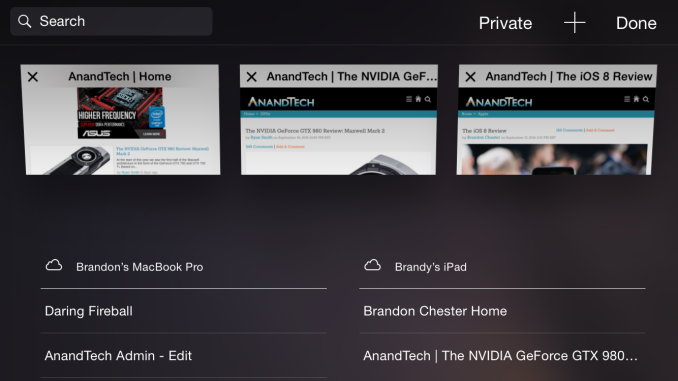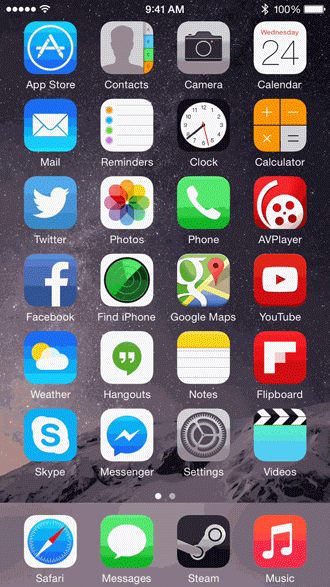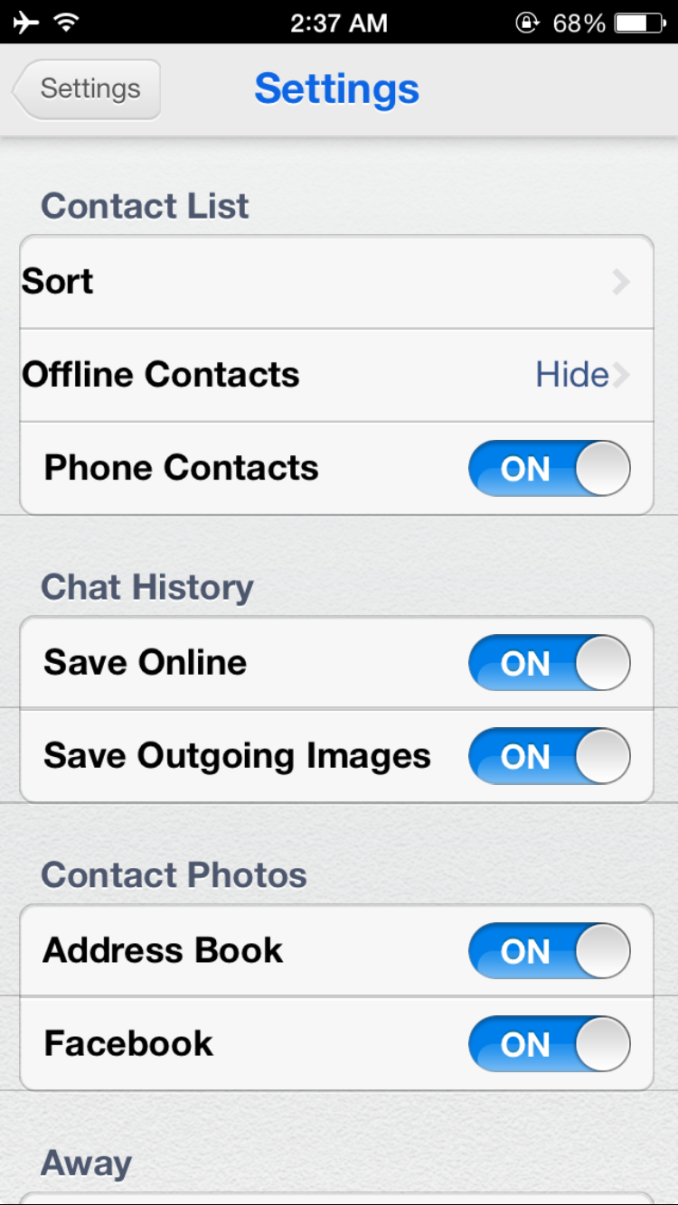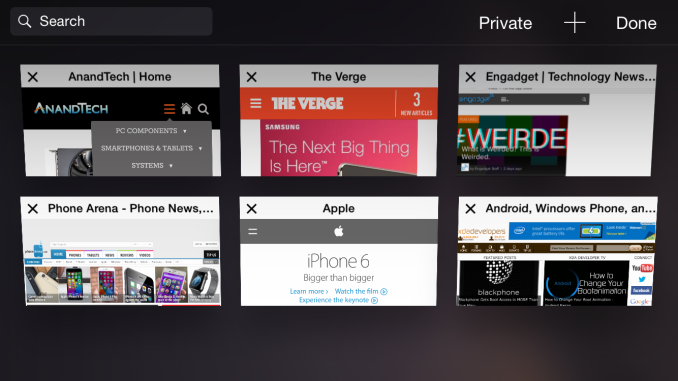The iPhone 6 Review
by Joshua Ho, Brandon Chester, Chris Heinonen & Ryan Smith on September 30, 2014 8:01 AM EST- Posted in
- Smartphones
- Apple
- Mobile
- iPhone 6
Design
The iPhone 6 comes with Apple’s newly released iOS 8. For a full rundown of everything Apple is bringing to the table with iOS 8 you can read our review of the operating system itself. iOS 8 also includes changes that are specific to the iPhones 6 and 6 Plus. Much like when Apple moved from the 3.5” 3:2 display in previous iPhones to the 4” 16:9 display on the iPhone 5, these changes are to add support for the new display on the iPhone 6. The home screen now displays an additional row of icons, meaning that it fits even more than an iPad. In addition, all of Apple’s default applications have been updated to take advantage of the larger, higher resolution screen.
Weather. iPhone 6 on the left, iPhone 5s on the right.
In the case of applications like Calculator, the interface simply has larger assets with the same layout as the 4” iPhones. Other applications like Settings and Notes display the elements of the interface at the same size as previous iPhones which allows more to be fit on the screen. Unlike the iPhone 5 which shared the same width as previous iPhones, the increase in space applies along both display axes on the iPhone 6 Plus. This is well demonstrated by the new Weather application which now fits more of the hourly forecast horizontally and more of the weekly forecast vertically.
The keyboard has also been updated to take advantage of the larger display when in landscape mode. The right side of the keyboard has been given dedicated keys for moving the cursor left and right in a text box, as well as a period button. The left side has an undo key and a comma. When the emoji keyboard is enabled it also receives a dedicated button next to the toggle between letters and numbers/special characters.
Another application with landscape specific improvements is Safari. While the iPhone 6 does not get the new split landscape views in applications that the 6 Plus has, it does get the horizontal tab view in Safari and the sliding bookmark menu on the new tab page. What's interesting is that this Safari interface is nearly identical to that of the iPad version, which is similar to Safari on OS X Yosemite. The one difference is that tabs in the tab view that are from the same website do not stack on top of each other. Apple really seems to want a unified interface and experience for Safari across all of their platforms, and the general design of the interface has translated well to the various different display sizes on iOS and OS X devices.
The iPhone 6 includes a feature called Reachability for users who find the increased display size difficult to use with one hand. Apple is late to the party with their larger displays, and we’ve seen attempts in the past by other manufacturers to make large devices easier to use. Shrinking the interface and displaying it in a bottom corner was a feature Samsung introduced with the Galaxy Note 3. It wasn’t a very elegant solution, but it worked. Apple’s Reachability feature uses a similar idea but implements it in a more elegant fashion. Double-tapping the capacitive ring around the home button shifts the display downward so the top of applications can be easily pressed. Once an action is performed the interface shifts back into position.
The last new feature specific to the new iPhones is Display Zoom. Display Zoom increases the size of what is displayed so that the interface displays the same amount of information that is shown on the iPhone 5, with an internal rendering resolution of 1136x640. This means that all icons, buttons, etc. are displayed in a much larger size than the default view setting. Because everything is being scaled up to the 1334x750 panel, the interface suffers from the slight blurring that you also see in third party apps that have not been updated to support the new iPhones. This feature is likely aimed at users with aging eyes who would like a bigger display to display bigger controls rather than to display more content, and who aren't concerned about having the sharpest text.
A notable feature that is missing is Apple's new Apple Pay service that works with the NFC hardware in the iPhone 6 and 6 Plus. Although Apple Pay is a feature of the new iPhones and of iOS 8, the service will not be rolling out until October. Other iOS 8 features like SMS Relay and iCloud Photo Library were also absent from the initial iOS 8 release and are scheduled to launch in October. It's likely that the fact that the iOS 8 release date is determined by the yearly release of new iPhones forced some features to be pushed back to a later update.
UX
While the design of iOS 8 itself is generally well-implemented, the user experience ends up a bit more mixed, and the result comes from the confluence of hardware and software. In the case of the iPhone 6, these issues effectively boil down to RAM and odd layouts that come from the upscaling needed for the 1334x750 display. In the case of upscaling artifacts, this is a temporary issue at best but it's glaringly obvious when an application is upscaled in certain cases.
For example, Trillian is an IM application that hasn't been updated in over a year. While it was already lacking in functionality with iOS 7 as it lacked support for the background refresh API, on the iPhone 6 in iOS 8 there are significant issues with consistent spacing and there's also no support for third party keyboards. Once again, it's important to understand that this isn't the result of poor work on Apple's part, but it does show the limits of what can be done with the upscaling system and emphasizes the need for developers to keep their applications updated.
The other issue has the potential to be far more serious. While iOS' software architecture is more RAM efficient due to manual garbage collection and the use of precompiled binaries, it's quite easy for me to push the phone past the breaking point in Safari. For example, six tabs of common websites for mobile devices cannot consistently be held in memory. If I continuously go through all six tabs, at least one will need to reload. In my first attempt at running this test, Safari crashed as I tried to go through all tabs constantly to keep them in memory. I didn't notice this behavior in the new Moto X, which can do the same test without issue. Outside of memory intensive use cases though, the iPhone 6 does respectably and I usually don't notice the lack of RAM. I have to emphasize that this should be a generally unlikely problem, and that the same behavior can be replicated on the iPhone 5s given the same workload. If you did not have issues with out of memory crashes before, there won't be any issues now.
Outside of these two flaws, there's really a lot to like. iOS continues to deliver a relatively well-polished experience that few seem to be able to match. Most of my issues from the iPhone 5s experience have been resolved. For example, it's now possible for me to upload photos to Dropbox selectively instead of turning camera upload on and deleting photos that I don't want to upload. The odd segregation of current notifications and missed notifications has been removed. Swiftkey has been added, although it's not quite the same as the Android version due to the different prediction insertion behavior and keyboard layout.
In addition, although it isn't necessarily the result of software, the larger display really helps with improving touch accuracy when compared to the iPhone 5s. While I haven't been able to try out Apple Pay since it will be launching in October, it also seems to be quite intriguing as the NFC solution is quite novel, though I'd like to see further use of NFC outside of payment and similar applications. TouchID continues to be a key differentiator, and the use of TouchID for Apple Pay authentication would definitely show the strength of Apple's hardware and software integration.



















531 Comments
View All Comments
thrasher32 - Tuesday, October 14, 2014 - link
That must be some really good crack there chiefGerryS - Wednesday, October 1, 2014 - link
Absolutely. If it can't be built into the price of the product, there's no incentive to innovate, at all.perpetualdark - Friday, October 3, 2014 - link
Not true, you innovate to stay in the game, not to increase your price point. Part of the "innovation" of the android flagships has been their ability to increase technology, form, and function while reducing or maintaining costs. Both the M8 and the S5 were selling for $99 on contract within a month of launch (by Verizon). Apple might have sold a lot of phones in this launch, but that was mostly due to the fact that there hasn't been an "innovation" in several years, and very little reason to buy an Apple product for at least 2 generations. Just keep watching to see how sales hold up after the initial storm is passed. In a few months when you can buy an S5 or M8 for $99 on contract, or an iPhone for $299, which do you think will sell better? And in 6 months, both companies will have the next gen of flagship out, with superior specs across the board and will launch at the same price as Apple, because the iphone 6 will STILL be $299.bigstrudel - Tuesday, September 30, 2014 - link
Samsung uses Off-the-shelf SoC's for every flagship device outside of Korea. Nothing impressive about that.techconc - Thursday, October 2, 2014 - link
@danbob999 - Samsung's SoC designs are basically equivalent to Apple's early A4 and A5 work. They essentially just use off the shelf reference designs and put them together to meet their own specifications. Yes, there is some work involved with doing that, but to date, this hasn't been a competitive advantage for Samsung like it has for Apple. In fact, Samsung ends up using Qualcomm chips for a very large percentage for their devices. Likewise, putting them in the same league as what Apple, Qualcomm or even nVidia is doing isn't quite right. They're not in the same league design wise.Samsung attempts to add layers of customization (Touchwiz, etc.) on top of Android, but it just feels like a clumsy layer on top and ends up dropping performance and resources for the device overall. Such customizations are no substitute for writing your own OS and controlling the entire technology stack. That's why a Samsung phone will always feel clumsy as compared to an iPhone. Samsung would have to to the Tizen route to attempt to compete on that level.
Chaser - Wednesday, October 1, 2014 - link
Now this is amusing. The OS hasn't changed since it launch except for, wait for it: pull down notifications! Amazing. But seriously its the same floating blobs that sit in rows on a screen. Designed for teenagers and grandparents in mind.techconc - Thursday, October 2, 2014 - link
@Chaser - Thanks for sharing your ...wait for it... ignorance on OS design and what's actually changed over the years. It should suffice to say that you clearly don't know what you're talking about.shm224 - Thursday, October 2, 2014 - link
@techconc : Sure, would you mind giving us some examples of such "changes" in iOS?techconc - Monday, October 6, 2014 - link
@shm224 - LOL! Not interested in doing a commercial for Apple and the listing surely wouldn't fit in a forum post. Google is your friend... If you're really interested, you can start with something like the Wikipedia entry for iOS and of course consult the release notes for each iOS release on Apple's developer site.michael2k - Thursday, October 2, 2014 - link
What? It gained an app store, popup notifications, printing, multitasking, search, pull down notifications, pull up settings, folders, multiple homescreens, enhanced notifications (reply, dismiss, widgets), and file sharing.